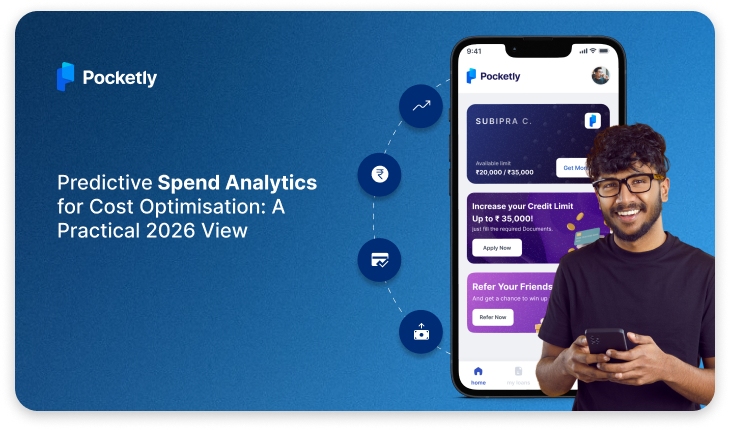
Ever wondered how banks decide whether to approve your loan? It’s not just about your credit score—one of the most important factors is your FOIR, or Fixed Obligations to Income Ratio. Think of FOIR as a quick snapshot of your financial health. It tells lenders how much of your monthly income is already tied up in expenses like loan EMIs, credit card payments, or rent and whether you can comfortably take on more debt.
Imagine this: if a significant chunk of your salary is already going toward existing obligations, it signals to lenders that you might struggle to repay a new loan. On the other hand, if your financial commitments are manageable, it increases their confidence in your ability to repay.
If you’ve ever faced loan rejection or struggled with high EMIs, understanding FOIR can be your helping hand. It’s not just about improving your chances of approval; knowing your FOIR also helps you make better financial decisions.
Let’s break it down into simple terms and see why FOIR is so important when you’re applying for a loan.
What is FOIR?
FOIR stands for Fixed Obligations to Income Ratio, and it’s a fancy way of saying: “How much of your income is already being used to pay off existing commitments?”
Banks and lenders use this ratio to measure your repayment capacity. It includes all your monthly financial obligations, like loan EMIs, credit card dues, and other fixed expenses, divided by your gross monthly income.
Why is FOIR Important?
- It helps lenders evaluate your financial stability.
- A lower FOIR means you have enough room to manage additional debt.
- A higher FOIR might indicate financial strain, making lenders cautious about approving your loan.
Let’s understand FOIR in more detail and how it is calculated. Keep scrolling through!
Understanding FOIR Calculation: What It Includes
Before diving into the calculation, let’s understand why FOIR is important. FOIR, or Fixed Obligations to Income Ratio, is a key metric banks and lenders use to determine if you can handle additional debt. It measures how much of your monthly income is already tied up in fixed obligations like loan EMIs, credit card payments, or rent. The lower your FOIR, the more confident lenders are about your ability to repay new loans.
Now, let’s explore how FOIR is calculated and what goes into it.
How is FOIR Calculated?
FOIR = (Total Monthly Fixed Obligations / Gross Monthly Income) x 100
This simple formula gives lenders a clear percentage of your income already committed to financial obligations.
What’s Included in FOIR?
- Loan EMIs: Regular monthly payments for personal, car, or home loans.
- Credit Card Dues: Any fixed amounts you owe on credit card repayments.
- Other Fixed Expenses: Recurring commitments such as rent or insurance premiums.
These obligations together form the “fixed” part of your monthly outgoings.
What’s Included in Gross Monthly Income?
- Salary Income: Your total earnings before deductions like taxes and provident fund contributions.
- Other Income Sources: Any extra income, such as freelance work, rental property earnings, or bonuses.
By comparing your fixed obligations to your gross income, FOIR provides a snapshot of your financial capacity. A low FOIR means you’re managing your money well and have room to take on more debt. On the other hand, a high FOIR could signal financial stress, making lenders hesitant to approve your loan.
Understanding how FOIR is calculated helps you take control of your finances and improve your eligibility for future credit.
Why FOIR Matters for Loan Eligibility
FOIR, or Fixed Obligations to Income Ratio, isn’t just a number—it’s a clear indicator of your financial stability. Lenders use it as a key tool to evaluate whether you’re capable of repaying a new loan without stretching your finances too thin.
Significance of FOIR in Loan Eligibility
- Financial Stability Check: A low FOIR tells lenders you’re managing your finances responsibly and are less likely to default on your loan.
- Recommended FOIR Range: Most lenders prefer FOIR to be between 40% and 55%. Staying within this range improves your chances of approval.
- Loan Approval Confidence: A lower FOIR reflects higher repayment capacity, making lenders more willing to approve loans with favourable terms.
FOIR acts as a green flag for lenders, giving them confidence in your financial health and repayment ability.
How FOIR Impacts Loan Approval
When applying for a loan, your FOIR plays a significant role in the final decision. Here’s how it influences your approval chances:
High FOIR
- Indicates that a significant portion of your income is already committed to other obligations.
- Lenders may see this as a sign that you have limited capacity for additional debt, increasing the risk of rejection or reduced loan offers.
Low FOIR
- Reflects that your current debts are manageable, leaving enough room in your budget for a new loan.
- Suggests better financial health, making approval more likely and allowing for potential negotiations on loan terms.
Critical in Risk Assessment
- Lenders rely heavily on FOIR to assess the risk associated with lending to you.
- It also provides a basis for discussions with lenders, helping you secure better rates or higher loan amounts if your FOIR is low.
By understanding the significance and impact of FOIR, you can better manage your financial profile and increase your chances of securing a loan with favourable terms. A well-maintained FOIR isn’t just a requirement, it’s an asset in your financial toolkit.
Smart Strategies to Reduce FOIR
If your FOIR is on the higher side, don’t worry—there are effective ways to bring it down and improve your loan eligibility. Reducing your FOIR not only strengthens your financial profile but also boosts your chances of getting approved for credit with favourable terms.
Strategies to Reduce FOIR
- Increase Your Income: Explore additional income streams like freelancing, part-time jobs, or requesting a promotion. A higher income directly lowers your FOIR percentage.
- Pay Off High-Interest Debts: Focus on clearing debts like credit cards or personal loans with higher interest rates. This reduces your fixed obligations and frees up more of your income.
- Maintain a Healthy Credit Profile: Keep your credit utilisation ratio below 30% and ensure timely payments to maintain a strong credit history. This improves your overall creditworthiness.
- Apply with a Co-Applicant: Adding a co-applicant, such as a spouse or family member, can help divide the loan burden. Their income contributes to the FOIR calculation, lowering your ratio.
Implementing these strategies not only helps you reduce your FOIR but also makes you a more attractive candidate for lenders.
FOIR Standards Across Banks
When it comes to FOIR, banks don’t have a one-size-fits-all approach. Each lender has its own criteria based on their risk appetite and loan products.
What to Know About FOIR Standards
- Bank-Specific Limits: Some banks may accept a FOIR as high as 60%, while others might stick to a stricter limit of 40%.
- Loan Type Matters: FOIR requirements can also vary depending on the loan type. For instance, home loans may allow higher FOIRs due to longer repayment terms, while personal loans might have stricter limits.
- Customised Assessments: Banks often evaluate FOIR on a case-by-case basis, especially for applicants with strong credit scores or additional income sources.
Understanding the FOIR criteria of your preferred bank helps you plan better and improves your chances of meeting their loan eligibility requirements.
By reducing your FOIR and aligning with bank-specific standards, you can confidently approach lenders and secure loans without unnecessary hurdles.
How Lenders Calculate FOIR
Lenders rely on FOIR, or Fixed Obligations to Income Ratio, to evaluate whether you can comfortably handle additional debt. It’s a simple calculation that provides insights into your financial commitments versus your income. Understanding how it’s calculated can help you better prepare for loan applications.
Steps Lenders Follow to Calculate FOIR
- List Total Monthly Obligations:
- Includes all fixed monthly payments, such as:
- Loan EMIs: Payments for existing personal, car, or home loans.
- Credit Card Payments: Fixed monthly dues or minimum payments.
- Other Obligations: Regular expenses like rent, insurance premiums, or any other recurring commitments.
- Includes all fixed monthly payments, such as:
- Determine Gross Monthly Income:
- The income figure before any deductions, including:
- Salary: Total earnings, excluding taxes or provident fund deductions.
- Other Income: Additional sources like freelance work, rental income, or bonuses.
- The income figure before any deductions, including:
- Apply the FOIR Formula:
- FOIR = (Total Monthly Fixed Obligations / Gross Monthly Income) x 100.
- Assess the Percentage:
- Lenders use the resulting percentage to determine if your obligations are within acceptable limits.
What FOIR Reveals to Lenders
- Low FOIR: Indicates financial stability and capacity to manage new loans. Typically, a FOIR below 40% is seen as ideal.
- High FOIR: Suggests your income is largely tied up in existing commitments, making additional loans riskier.
By following this method, lenders can clearly see your financial health, helping them make informed decisions about your loan eligibility.
When it comes to seeking financial help, we all aim for the best—especially when it’s about getting an instant personal loan. Reliability and trustworthiness are non-negotiable in a lending platform. So, which one should you choose? That’s where Pocketly steps in!
Let’s explore how this pocket-friendly lending platform makes borrowing simple and stress-free.
Pocketly: Your Instant Loan Partner
When unexpected expenses arise, you need a solution that’s quick, reliable, and stress-free. That’s where Pocketly comes in—a digital lending platform designed to meet your short-term financial needs with ease. Whether you’re a student managing daily expenses or someone needing urgent cash, Pocketly has got your back!
Why Choose Pocketly?
Here are some standout features that make Pocketly the go-to option for instant loans:
- Quick Approvals: Pocketly ensures you don’t waste time waiting. Apply through the app, and get your loan approved in just a few minutes.
- Transparent Fees: Say goodbye to hidden charges! With Pocketly, you know exactly what you’re paying, making it completely hassle-free.
- Flexible Loan Amounts: Whether you need ₹1,000 or ₹25,000, Pocketly offers tailored loan amounts to suit your needs.
- Accessible for 18+: Students and young professionals can breathe easy, Pocketly is available to anyone aged 18 and above.
- Convenient App Experience: Manage your loan application, track payments, and access customer support—all in one easy-to-use app.
With Pocketly, you’re not just getting a loan; you’re gaining a financial partner who understands your needs and delivers fast, transparent, and flexible solutions.
If you want to apply for an instant personal loan with Pocklety, learn more in detail with our guide, Instant Quick Cash Loan in 1 Hour.
Conclusion
Understanding FOIR isn’t just about improving your chances of loan approval—it’s about taking control of your financial health. By keeping track of your fixed obligations and managing your income wisely, you can ensure your FOIR stays within a healthy range, making you a more attractive candidate for lenders.
Whether it’s paying off high-interest debts, increasing your income, or maintaining a balanced credit profile, small steps can make a big difference in your financial journey.
But let’s face it—sometimes unexpected expenses pop up, and you need immediate funds. Plus, if you’re 18+ and need quick cash without worrying about hidden charges, Pocketly has got you covered! With fast approvals, transparent terms, and loan amounts ranging from ₹1,000 to ₹25,000, Pocketly makes borrowing simple and stress-free.
Get on board with the Pocketly app today and handle your financial needs with confidence!
FAQs
What is FOIR, and why is it important?
FOIR, or Fixed Obligations to Income Ratio, measures how much of your income goes toward fixed monthly expenses. It’s crucial as lenders use it to assess your loan repayment capacity.
What is the ideal FOIR range for loan approval?
Most lenders prefer a FOIR between 40% and 55%. A lower FOIR improves your chances of loan approval with better terms.
How can I reduce my FOIR?
You can lower your FOIR by increasing your income, paying off high-interest debts, reducing credit utilisation, or applying for a loan with a co-applicant.
Does FOIR affect all types of loans?
Yes, FOIR is considered for most loans, including personal, home, and car loans. However, the acceptable range may vary depending on the type of loan and lender policies.
Can I apply for a Pocketly loan if I’m 18 years old?
Yes, Pocketly allows users aged 18 and above to apply for loans, making it accessible for students and young professionals.
Does Pocketly have any hidden charges?
No, Pocketly is completely transparent with its fees and charges. You’ll know all costs upfront before accepting the loan.
How much loan can I get through Pocketly?
Pocketly offers loan amounts ranging from ₹1,000 to ₹25,000, perfect for covering urgent expenses or short-term financial needs.
















